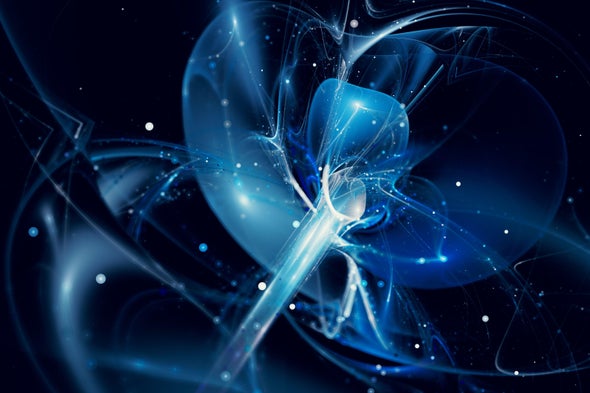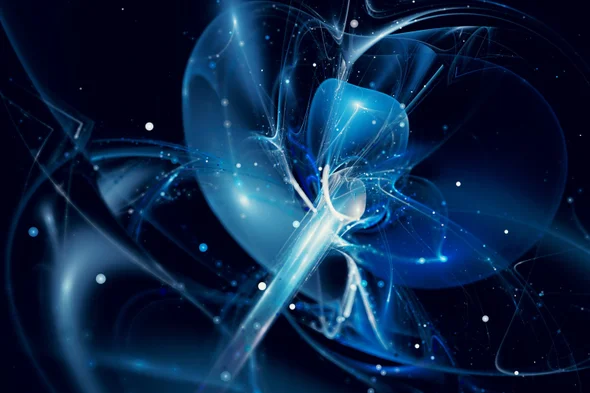![]()
The strange phenomenon of quantum tunneling has been observed in a chemical reaction that defies classical physics

A chemical reaction is a bit like traveling from Vienna to Venice: your destination might be downhill, but to get there, you’ll need to cross the Alps. You can think of the energy changes molecules must go through as a landscape. Between the start and end of a reaction, this terrain can sometimes be so hilly that otherwise favorable reactions don’t happen at all if molecules lack the energy to make it over the bumps. Yet in some of these cases, such reactions do happen, thanks to quantum tunneling, which allows particles to occasionally bore through energy barriers they’d never be able to climb. This bizarre behavior is forbidden in traditional physics but allowed under the wild rules of quantum mechanics.
Now, in a new study published in Nature, scientists have managed to spot quantum tunneling in what classical physics would deem an impossible reaction between hydrogen molecules and deuterium ions—heavy, charged versions of hydrogen. This is the first time that researchers have managed to experimentally confirm a theoretical prediction about the rate of tunneling in a reaction involving ions. “Quantum mechanics in theory should be able to predict this [rate] very well,” says physicist Stephan Schlemmer of the University of Cologne in Germany, who was not involved in the study. “But nobody was sure whether this was really true.”
The idea that a particle could simply appear on the other side of an energy barrier traces back to German physicist Friedrich Hund. In 1927, while researching how molecules interact with light, he discovered that tunneling should be theoretically possible. According to quantum mechanics, particles are more like clouds of probability than solid spheres. These probability clouds, representing the location of a particle, extend out to infinity. So although it’s exceedingly unlikely, a quantum particle can theoretically pop up anywhere, including on the other side of an energy barrier that a classical particle could never cross.
In 1928 tunneling enjoyed perhaps the greatest of its first triumphs: tidily explaining nuclear alpha decay, a common type of radioactive decay in which atomic nuclei spit out “alpha particles”—helium nuclei with two protons and two neutrons—and transform into smaller nuclei in the process. This happens when the three atoms of a hydrogen molecule and deuterium ion approach one another in a line, and one hydrogen atom hops over to bond with the deuterium instead. At low temperatures, this reaction should be impossible, but it works with tunneling. Since then scientists have used tunneling to explain the otherwise unexplainable in contexts ranging from semiconductors to the hearts of stars.
But even though the idea behind quantum tunneling is now nearly a century old, bringing theory and experiment together to observe tunneling in chemical reactions has proved tricky. First, quantum tunneling is rare enough that reactions dependent on it are usually glacially slow, making them tough to watch in the lab. And then there are the theoretical calculations themselves, which involve math so complicated that scientists can only predict tunneling reaction rates for the very simplest reactions. “With [reactions among] three atoms, you can do it,” says molecular physicist Roland Wester of the University of Innsbruck in Austria, who co-authored the new study. “With four atoms, there are a couple of groups who can handle it. And with five atoms, there’s basically nobody in the world who has the means to do it fully quantum.”
The reaction between hydrogen gas and deuterium ions is simple enough that it’s possible to predict the reaction rate with quantum mechanics alone. That is why Wester’s team chose to study this reaction: the researchers could actually check theory against reality. In the reaction, a molecule of hydrogen gas collides with one deuterium ion to produce a hydrogen ion and a heavy, deuterium-containing hydrogen molecule. But when theoretical physicist Viatcheslav Kokoouline of the University of Central Florida and his colleagues crunched the numbers in 2018, they predicted a reaction rate that was hundreds of times lower than the upper-limit estimate that was previously measured by Wester’s team.
“[The results] disagreed so much with the experiments, we didn’t want to publish,” Kokoouline says. Worried that they had made a mistake, he and his colleagues repeated their calculation using three different theoretical methods and got the same result. It was certainly possible that the calculations were wrong, but “we tried our best, and this is the number we [could] provide,” says Kokoouline’s former student Isaac Yuen, who is now a theoretical physicist at Kansas State University.
The problem was the reaction’s extremely slow rate, which took the Innsbruck team about 15 years of troubleshooting and tinkering to finally measure accurately. To do it, the researchers trapped deuterium ions in a cage of electric fields, flushed them with hydrogen gas and cooled everything down to an extremely chilly 15 kelvins. At temperatures that cold, the hydrogen and deuterium lacked the energy to react without tunneling. After waiting for about 15 minutes, the scientists measured how many hydrogen ions had been produced to find the reaction rate.
Fifteen minutes doesn’t sound like much, but for classical reactions, scientists often take measurements “for 100 milliseconds, and they see almost all ions converted to product,” Wester says. “We waited 1,000 seconds, and less than 1 percent of the ions converted into products.”
Tunneling occurred only about one in every 100 billion collisions between hydrogen and a deuterium ion, which agrees very well with Kokoouline and Yuen’s theoretical calculations. “It feels quite amazing that the numbers match with the experiments,” Yuen says. “I feel like it’s a big triumph, as a theorist.”
Tunneling reactions between ions such as this one are thought to be important for chemical synthesis in the diffuse, interstellar soup of ionized gas that provides the raw material for new star systems. Because the interstellar medium is so cold, classical reactions are very slow, but tunneling is more likely—particles move past each other more slowly at low temperatures, which ups the odds of tunneling.
Here on Earth, capturing this tiny tunneling rate for the first time shows that physicists are on the right track with their quantum molecular theories. And it provides a benchmark for testing future theoretical efforts to unite chemistry and quantum mechanics. “[In] our regular world of classical particles, reactions can be understood with some very simple concepts,” Schlemmer says. “But this tunneling is just a completely different world. And measurements like this open this world to us.”




